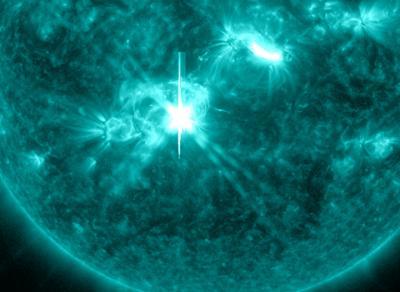On Oct. 23rd, 2013, the sun emitted a solar flare, classified as an M9.4 flare on a scale from M1 to M9.9 - near the very top of the scale for M class flares.
Solar flares are powerful bursts of radiation. Harmful radiation from a flare cannot pass through Earth's atmosphere to physically affect humans on the ground, but when they are intense enough they can disturb the atmosphere in the layer where GPS and communications signals travel. Such radiation can disrupt radio signals for as long as the flare is ongoing, anywhere from minutes to hours.
M class flares are the weakest flares that can still cause pace weather effects near Earth. In the past, they have caused brief radio blackouts at the poles. The next highest level is X-class, which denotes the most intense flares.

NASA's Solar Dynamics Observatory or SDO, captured this image on the sun of an M9.4-class solar flare, which peaked at 8:30 pm EDT on Oct. 23, 2013. The image displays light in the wavelength of 131 Angstroms, which is good for viewing the intense heat of a solar flare and typically colored teal. Credit: NASA SDO
Increased numbers of flares are quite common at the moment, since the sun is near solar maximum. Humans have tracked solar cycles continuously since they were discovered in 1843, and it is normal for there to be many flares a day during the sun's peak activity.
To see how this event may impact Earth, please visit NOAA's Space Weather Prediction Center at http://spaceweather.gov, the U.S. government's official source for space weather forecasts, alerts, watches and warnings.






Comments